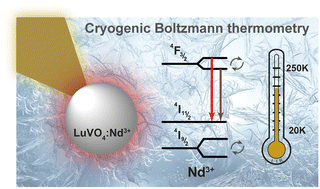Boltzmann-type cryogenic ratiometric thermometry based on Nd3+-doped LuVO4 phosphors†
Abstract
Contactless optical thermometry with high sensitivity, temperature resolution, and fast response is strongly needed for application in various fields including scientific research, life activities, and industrial manufacturing processes. Boltzmann-type ratiometric thermometry relying on electron redistribution between thermally coupled levels is one of the most reliable sensing techniques. However, the use of this strategy is significantly limited at cryogenic temperatures due to the relatively large energy gap between thermally coupled levels in comparison with thermal energy. In this paper, we propose a strategy to provide cryogenic thermometry by using thermally coupled excited and ground Stark sublevels of LuVO4:Nd3+ samples. Reliable Boltzmann-type optical thermometry was performed in wide ranges of 20–250 K and 75–250 K using emission and excitation spectra, respectively. The maximal relative thermal sensitivity achieved was 14.14% K−1, while the best temperature resolution was 0.17 K. This work offers a prospective strategy to provide precise and effective optical thermometry, including at ultralow temperatures.



 Please wait while we load your content...
Please wait while we load your content...